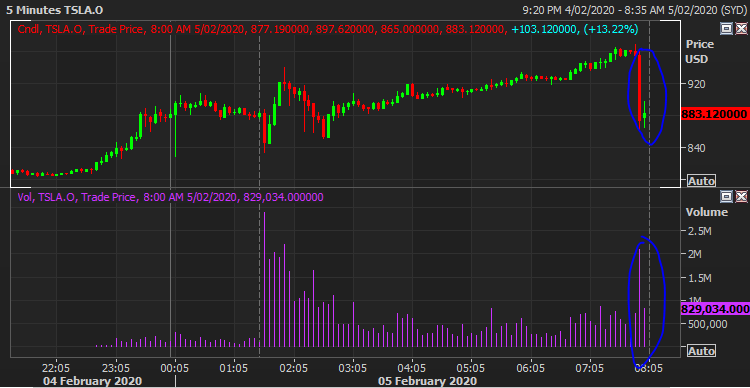- Risk appetite takes pause after huge overnight rally.
- Asia high beta to the downside as CBs respond to nCoV concerns.
- The Lowe down on the RBA's "Year Ahead" speech.
Marginal retracement
After last night's broad risk-rally, Asia's willingness to continue the move has been met with a bit more trepidation.
ASX climbed higher but only just, gaining 0.39%. Benchmark futures across the board point down as investors walk into Europe.
FTSE and
DAX both eye a soft start having managed to breach multi-week trend resistance. The truth of the matter is that nCoV's impact remains significant and unknown, and still demands immediate interest from most affected economies.
Tesla
From the sidelines, it's been nothing short of an impressive bout of price action for the incumbent electric car-maker, whose market-cap currently sits at an incredulous $170bn. For reference,
Tesla (TSLA) has well and truly doubled what it was trading at on Dec. 31, a meagre $432 compared to its current $870 (traded into $960 during extended hours).
The stock has taken all but a mere 8 weeks to triple its market cap; surpassing that of Mcdonald's, dwarfing Ford's and edging closer to Toyota's mantle. While Short sellers have clearly been decimated since the release of 4Q results, how long Tesla's victory lap lasts for is anyone's best guess. One thing for sure - volatility in the stock has had a rude awakening, and those with short-term skin in the game will need thicker skin.
A decent block was sold just before the close (7.50am-7.55am AEDT) and could be a forewarning of more choppiness to come, especially as smart money might look to rotate around these elevated levels.

Source: Eikon
Asia sticking out
Performance to the downside is once again sticking out like a sore thumb in Asia markets especially against broader USD strength today. KRW was weaker by 0.7%, continuing to be driven by Coronavirus news flow. However, on a technical level, momentum might see USDKRW fall with slow stochastic crossing over to the downside.
SGD was equally unimpressed, sliding by some 0.9% to its weakest point since October, with interbank volumes well above average by around 5x. MAS were the key driver behind the move noting that the effective exchange rate has room to accomodate more easing after "fluctuating near upper bound of policy band". As Singapore remain heavily reliant on tourism and trade, nCoV economic disruption puts SGD under pressure.
THB weakness was also of interest after the central bank unanimously voted to cut the policy rate by 25bps.
There were more signs of buyer support on day 3 of China trading since reopening, though price action seemed reluctant to turbocharge. CSI 300, A50 and SSEC have lifted at time of writing, as have Chinese yields. China 1yr bond yields are ticking higher 4bps as bond flows lessen and equity inflows rise. USDCNH has edged back above 7 handle.
The Lowe down
RBA Gov. Lowe's speech wasn't as dovish as first envisaged, but definitely kept the door ajar for future rate cuts. On balance, Lowe seemed reluctant to catastrophise the impacts of Coronavirus and maintained a more optimistic stance regarding the future of Australia. Absent any deterioration in the labour markets or inflation expectations, the RBA sounded content that things were "moving in the right direction".
AUD overall was well held, if anything, managed to eke out a couple of pips to the topside. March pricing for an RBA rate-cut has now shifted to 12% likelihood. While only one full rate-cut is priced in by November, a stark difference from where we were at the start of the year. AUDNZD looks like it has tactical upside in the near-term.
NZ employment
NZD initially jumped, brushing 65c after what appeared to be a better than expected unemployment rate of 4%. But soon after corrected, settling for a 0.12% fall once details showed the print to actually be quite weak. A better unemployment rate was largely attributed to a drop in participation (70.4% to 70.1%), while actual employment turned out fairly negative (0% vs 0.3% est.).
Back